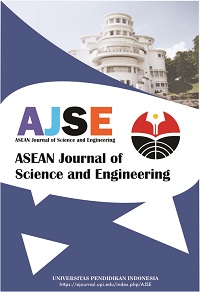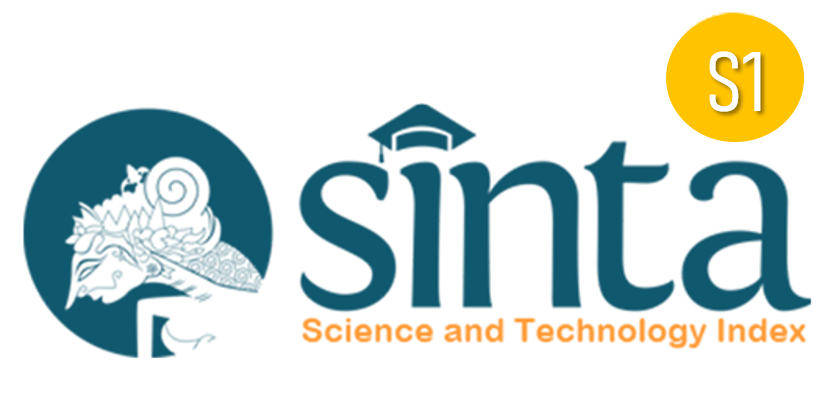Jakarta COVID-19 Forecast with Bayesian PIRD Multiwave Model
Abstract
Keywords
Full Text:
PDFReferences
Abusam, A., Abusam, R., and Al-Anzi, B. (2020). Adequacy of Logistic models for describing the dynamics of COVID-19 pandemic. Infectious Disease Modelling, 5, 536-542.
Aldila, D., Khoshnaw, S. H., Safitri, E., Anwar, Y. R., Bakry, A. R., Samiadji, B. M., Aldila, D., Khoshnaw, S. H., Safitri, E., Anwar, Y. R., Bakry, A. R., Samiadji, B. M., Anugerah, D. A., Gh, M. F. A., Ayulani, I. D., and Salim, S. N. (2020). A mathematical study on the spread of COVID-19 considering social distancing and rapid assessment: The case of Jakarta, Indonesia. Chaos, Solitons and Fractals, 139, 110042.
Andrews, N., Stowe, J., Kirsebom, F., Toffa, S., Rickeard, T., Gallagher, E., Gower, C., Kall, M., Groves, N., O’Connell, A. M., and Lopez Bernal, J. (2022). Covid-19 vaccine effectiveness against the Omicron (B. 1.1. 529) variant. New England Journal of Medicine, 386(16), 1532-1546.
Baker, H. A., Safavynia, S. A., and Evered, L. A. (2021). The ‘third wave’: impending cognitive and functional decline in COVID-19 survivors. BJA: British Journal of Anaesthesia, 126(1), 44.
Beira, M. J., and Sebastião, P. J. (2021). A differential equations model-fitting analysis of COVID-19 epidemiological data to explain multi-wave dynamics. Scientific Reports, 11(1), 1-13.
Blonigan, P., Ray, J., and Safta, C. (2021). Forecasting multi-wave epidemics through Bayesian inference. Archives of Computational Methods in Engineering, 28(6), 4169-4183.
Brunner, N., and Kühleitner, M. (2021). Bertalanffy-Pütter models for the first wave of the COVID-19 outbreak. Infectious Disease Modelling, 6, 532-544.
Burki, T. K. (2022). Omicron variant and booster COVID-19 vaccines. The Lancet Respiratory Medicine, 10(2), e17.
Cot, C., Cacciapaglia, G., Islind, A. S., Óskarsdóttir, M., and Sannino, F. (2021). Impact of US vaccination strategy on COVID-19 wave dynamics. Scientific Reports, 11(1), 1-11.
Heidari, M., and Jafari, H. (2021). Challenges of COVID-19 vaccination in Iran: In the fourth wave of pandemic spread. Prehospital and Disaster Medicine, 36(5), 659-660.
Helmi, M., Sari, D., Sulistyowati, Y., Meliala, A., Trisnantoro, L., Nurrobi, T., and Ratmono, T. (2021). The challenge of education and training in the covid-19 national emergency hospital wisma atlet Kemayoran in Jakarta. Avicenna, 2021(2), 10.
Heriyanto, R. S., Kurniawan, A., Wijovi, F., Halim, D. A., Jodhinata, C., Marcella, E., Susanto, B., Wibowo, J., Indrawan, M., Heryadi, N. K., and Lugito, N. P. H. (2021). The role of COVID‐19 survivor status and gender towards neutralizing antibody titers 1, 2, 3 months after Sinovac vaccine administration on clinical‐year medical students in Indonesia. International Journal of Infectious Diseases, 113, 336-338.
Horton, R. (2021). Offline: the case for No-COVID. Lancet (London, England), 397(10272), 359.
Husni Rahiem, M. D. (2021). Indonesian university students’ likes and dislikes about emergency remote learning during the COVID-19 pandemic. Asian Journal of University Education (AJUE), 17(1), 1-18.
Iin Rachmawati, I. R. (2020). Travelers' motivation to travel abroad during covid-19 outbreak. Jurnal IJASTE POLTEK Bali, 4(1), 1-11.
Islam, Q. T. (2022). Beta, Delta, Omicron–What’s next? Bangladesh Journal of Medicine, 33(2), 128-129.
Kamran, K. (2021). Third wave of COVID-19; Challenges and Strategies for Pakistan, a mini review. Frontiers in Public Health, 9, 893.
Karim, S. S. A., and Karim, Q. A. (2021). Omicron SARS-CoV-2 variant: a new chapter in the COVID-19 pandemic. The Lancet, 398(10317), 2126-2128.
Kaxiras, E., and Neofotistos, G. (2020). Multiple epidemic wave model of the COVID-19 pandemic: modeling study. Journal of Medical Internet Research, 22(7), e20912.
Lee, S. Y., Lei, B., and Mallick, B. (2020). Estimation of COVID-19 spread curves integrating global data and borrowing information. PloS One, 15(7), e0236860.
Locarso, G. K. (2022). Analisis sentimen review aplikasi peduli lindungi pada google play store menggunakan NBC. Jurnal Teknik Informatika Kaputama 6, 1, 339-346.
Lounis, M., and Raeei, M. A. (2021). Estimation of epidemiological indicators of COVID-19 in Algeria with an SIRD model. Eurasian Journal of Medicine and Oncology, 5(1), 54-58.
Maslo, C., Friedland, R., Toubkin, M., Laubscher, A., Akaloo, T., and Kama, B. (2022). Characteristics and outcomes of hospitalized patients in South Africa during the COVID-19 Omicron wave compared with previous waves. Jama, 327(6), 583-584.
Mbogo, R. W., and Orwa, T. O. (2021). SARS-COV-2 outbreak and control in Kenya-Mathematical model analysis. Infectious Disease Modelling, 6, 370-380.
Nasir, N. M., Joyosemito, I. S., Boerman, B., and Ismaniah, I. (2021). Kebijakan vaksinasi covid-19: pendekatan pemodelan matematika dinamis pada efektivitas dan dampak vaksin di Indonesia. Jurnal Pengabdian kepada Masyarakat UBJ, 4(2), 191 - 204.
Nemat, A., and Asady, A. (2021). The third wave of the COVID-19 in Afghanistan: an update on challenges and recommendations. Journal of Multidisciplinary Healthcare, 14, 2043.
Notari, A., and Torrieri, G. (2022). COVID-19 transmission risk factors. Pathogens and Global Health, 116(3), 146-177.
Novianti, K. R., and Roz, K. (2020). Teleworking and workload balance on job satisfaction: Indonesian public sector workers during covid-19 pandemic. Asia Pacific Management and Business Application, 9(1), 1-10.
Nuraini, N., Khairudin, K., and Apri, M. (2020). Modeling simulation of COVID-19 in Indonesia based on early endemic data. Communication in Biomathematical Sciences, 3(1), 1-8.
Rab, S., Javaid, M., Haleem, A., and Vaishya, R. (2020). Face masks are new normal after COVID-19 pandemic. Diabetes and Metabolic Syndrome: Clinical Research and Reviews, 14(6), 1617-1619.
Romagnani, P., Gnone, G., Guzzi, F., Negrini, S., Guastalla, A., Annunziato, F., Romagnani, S., and De Palma, R. (2020). The COVID-19 infection: lessons from the Italian experience. Journal of Public Health Policy, 41(3), 238-244.
Roosa, K., Lee, Y., Luo, R., Kirpich, A., Rothenberg, R., Hyman, J. M., Yan, P., and Chowell, G. (2020). Short-term forecasts of the COVID-19 epidemic in Guangdong and Zhejiang, China: February 13–23, 2020. Journal of Clinical Medicine, 9(2), 596.
Saifuddin, A., Koesnoe, S., Kurniati, N., Sirait, S., Arisanty, R., and Yunihastuti, E. (2021). COVID arm after moderna booster in healthcare worker: A case report. Acta Medica Indonesiana, 53(3), 326-330.
Sandoval-Reyes, J., and Idrovo-Carlier, S. i Duque-Oliva, EJ (2021). Remote work, work stress, and work–life during pandemic times: a Latin America situation. International Journal Environmental Research Public Health, 18, 7069.
Shim, E. (2021). Projecting the impact of SARS-CoV-2 variants and the vaccination program on the fourth wave of the COVID-19 pandemic in South Korea. International Journal of Environmental Research and Public Health, 18(14), 7578.
Suntronwong, N., Thongpan, I., Chuchaona, W., Budi Lestari, F., Vichaiwattana, P., Yorsaeng, R., Pasittungkul, S., Kitphati, R., Vongpunsawad, S., and Poovorawan, Y. (2020). Impact of COVID-19 public health interventions on influenza incidence in Thailand. Pathogens and Global Health, 114(5), 225-227.
Tanra, A. J., and Tusholehah, M. (2022). Lessons learned from COVID-19 pandemic: Indonesia's perspective. Taiwanese Journal of Psychiatry, 36(1), 5.
Vedhara, K. (2021). COVID-19 second wave: lockdown should not mean lock-up. Public Health, 190, e12.
Whitworth, J. (2020). COVID-19: a fast-evolving pandemic. Transactions of the Royal Society of Tropical Medicine and Hygiene, 114(4), 241.
Xie, L. (2022). The analysis and forecasting COVID-19 cases in the United States using Bayesian structural time series models. Biostatistics and Epidemiology, 6(1), 1-15.
Yang, L., Liu, S., Liu, J., Zhang, Z., Wan, X., Huang, B., Youhai Chen, and Zhang, Y. (2020). COVID-19: immunopathogenesis and Immunotherapeutics. Signal Transduction and Targeted Therapy, 5(1), 1-8.
Yang, P., Yang, G., Qi, J., Sheng, B., Yang, Y., Zhang, S., Bi, G., and Mao, X. (2021). The effect of multiple interventions to balance healthcare demand for controlling COVID-19 outbreaks: a modelling study. Scientific Reports, 11(1), 1-13.
Yap, O. F. (2020). A new normal or business-as-usual? Lessons for COVID-19 from financial crises in East and Southeast Asia. European Journal of Development Research, 32(5), 1504-1534.
Zahrotunnimah, Z. (2021). Indonesian Government Bureaucracy Efforts to Prevent Covid-19 at the Beginning of the Pandemic Period. Вестник Российского университета дружбы народов. Серия: Государственное и муниципальное управление, 8(2), 153-166.
Zhang, N. (2022). Rapid development of an updated mRNA vaccine against the SARS-CoV-2 Omicron variant. Cell Research 32, 4, 401-403.
Zhao, H., Lu, L., Peng, Z., Chen, L. L., Meng, X., Zhang, C., Lp, J. D., Chan, W. M., Chu, A. W. H., Chan, K. H., Jin, D. Y., and To, K. K. W. (2022). SARS-CoV-2 Omicron variant shows less efficient replication and fusion activity when compared with Delta variant in TMPRSS2-expressed cells. Emerging Microbes and Infections, 11(1), 277-283.
Zreiq, R., Kamel, S., Boubaker, S., Al-Shammary, A. A., Algahtani, F. D., and Alshammari, F. (2020). Generalized Richards model for predicting COVID-19 dynamics in Saudi Arabia based on particle swarm optimization Algorithm. AIMS Public Health, 7(4), 828.
DOI: https://doi.org/10.17509/ajse.v3i3.47248
Refbacks
- There are currently no refbacks.
Copyright (c) 2022 Universitas Pendidikan Indonesia

This work is licensed under a Creative Commons Attribution-ShareAlike 4.0 International License.












